 John Mata Jr.
.
February 17, 2022
.
c10
John Mata Jr.
.
February 17, 2022
.
c10
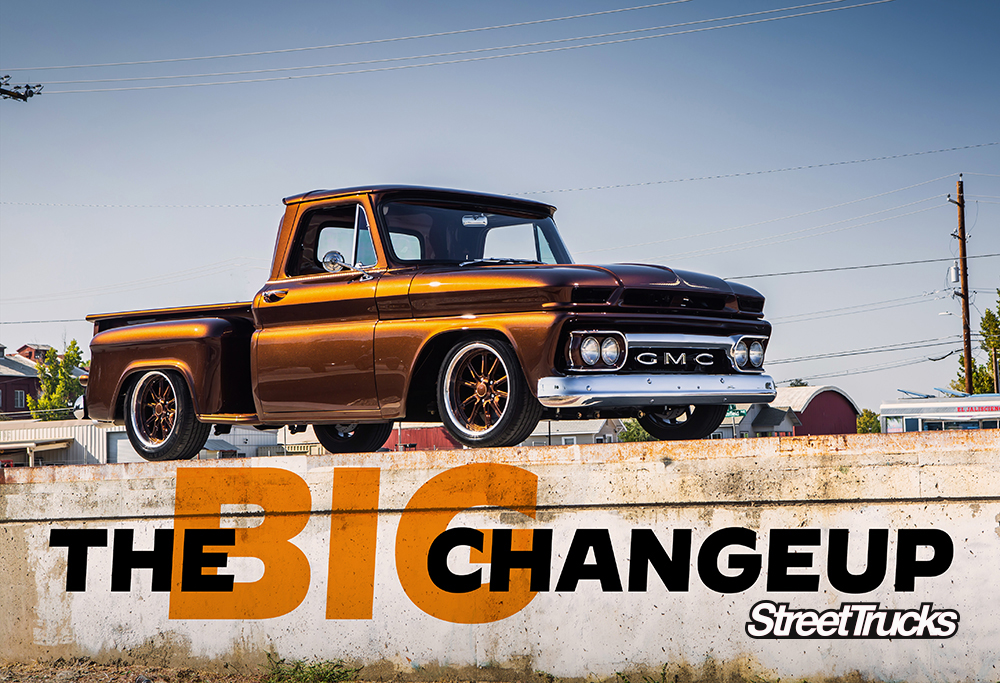
Fathers and sons share many types of hobbies, but few can bring them together (or send them into completely opposite directions) like the world of custom cars.
James Connerley’s father was the first owner of this ’65 GMC pickup, and his number one priority was to always keep it well maintained and on the road. While James’ dad didn’t do much in the way of customization throughout the years, the care he gave his truck left it in good enough condition for James to take over where his dad left off almost 20 years after he brought it home.
To get the wheels spinning and put the suspension into motion, James treated the GMC to a 2009 630-hp blown LS1 engine built by Rex Hutchison Racing in Sacramento. Yeah, it was a bit of a splurge, but nothing was too good for dad’s old pickup.
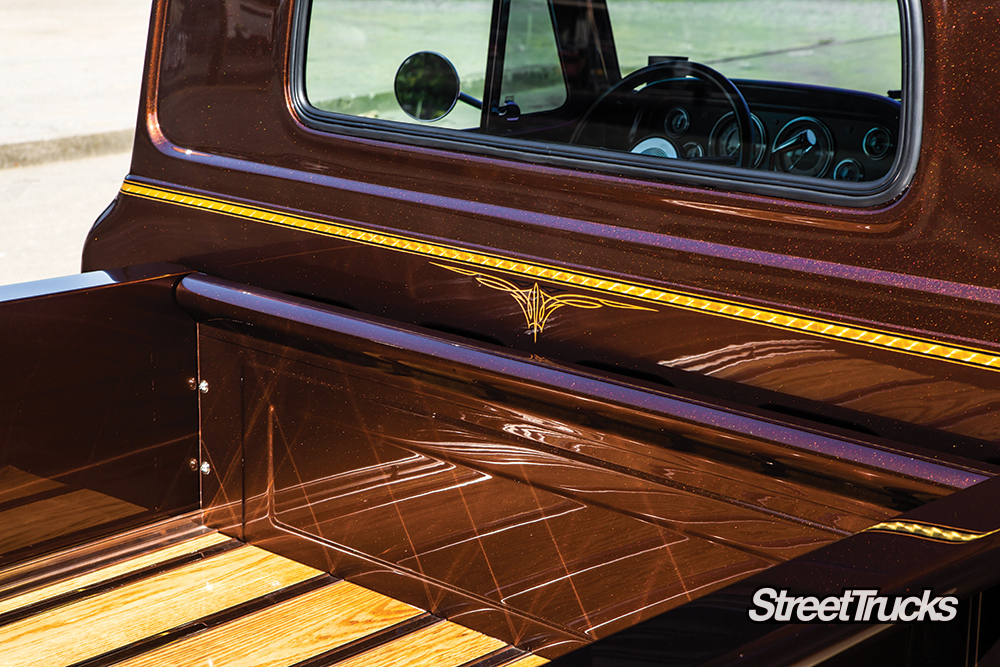
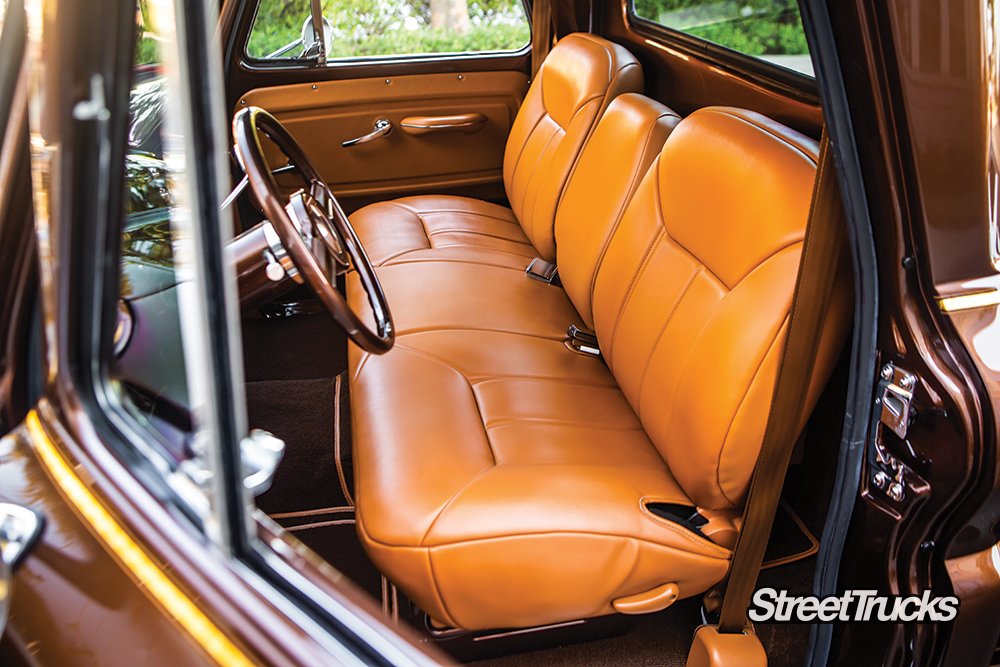 In 1983, James officially bought his dad’s GMC knowing darn well that wouldn’t be leaving it in its factory condition for too much longer.
In 1983, James officially bought his dad’s GMC knowing darn well that wouldn’t be leaving it in its factory condition for too much longer.
“My dad and I shared interest in the same truck, but we saw two totally different levels of potential for it,” James says.
You see, James has been into heavily customized vehicles since he was old enough to drive—something that his dad never really took much stock in.
“I can remember my dad always saying that the more things you do to a car means that more things can go wrong with it,” James says.
While the two Connerley men had two distinct visions for the same pickup, the time was finally set to change for the old ’65.
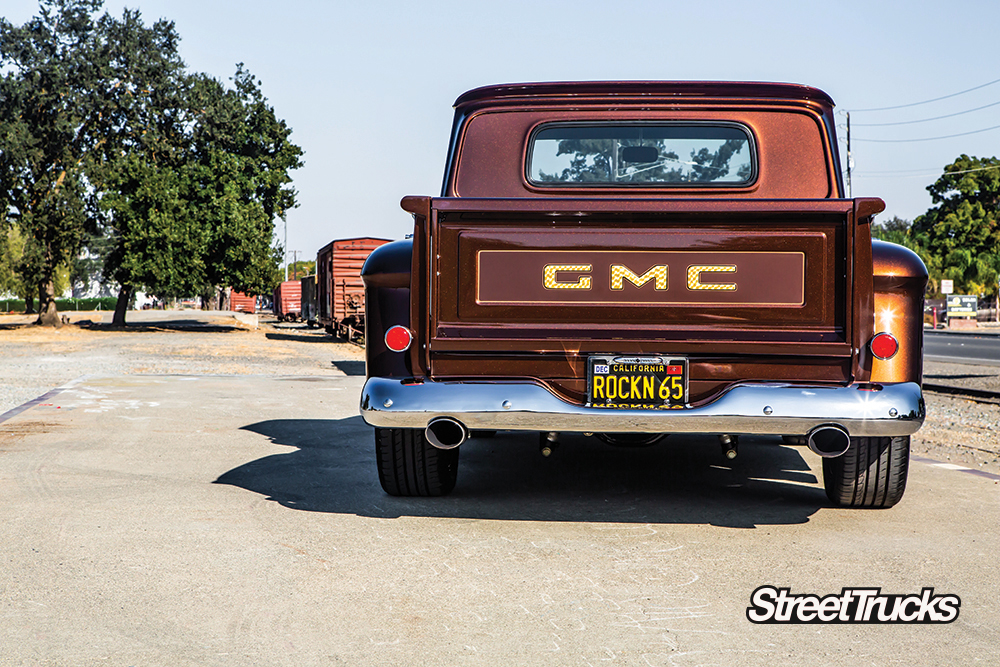
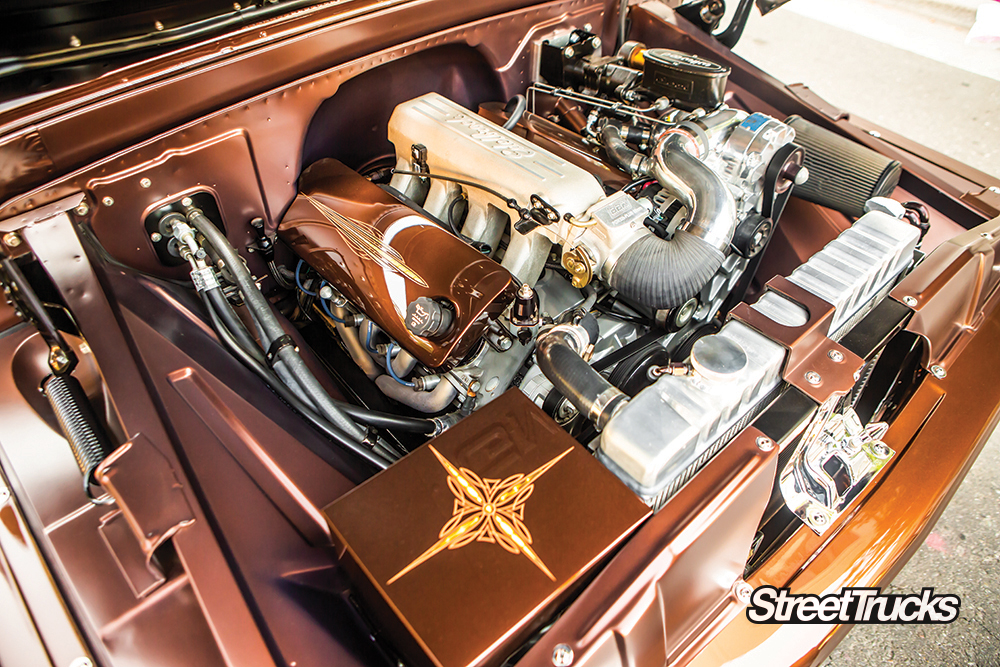
James has built up a solid list of talented contacts throughout his years of customizing, and the first number he dialed was Jeff Norene’s at Lee’s Vintage Car Shop in West Sacramento. Jeff had worked on James’ award-winning ’48 Chevy Sedan Delivery just a few years earlier, and as luck would have it, was more than willing to work his magic on the GMC truck project. The two threw some ideas around, but the ultimate plan of action was to keep the truck looking clean without going overboard on anything—James’ dad would certainly appreciate that sentiment. The ’65’s sheetmetal was still in good usable condition, and aside from some standard massage work, Jeff added a few goodies in the way of ’37 Ford taillights, custom tailgate latches, and a custom oak plank bed floor that was devised for a cool custom yet streamlined appearance.
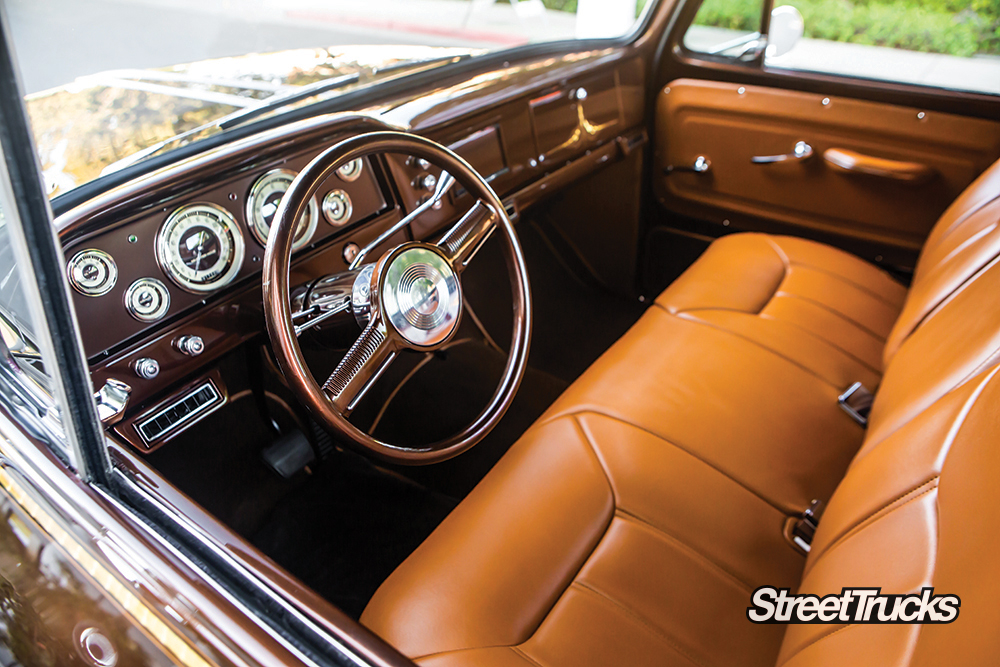
To seal the deal on the hours that were invested in getting the bodywork and mods just right, Jeff mixed up a custom PPG Envriobase Sunset Bronze color to coat the surface of the GMC. The hue is classy, classic and oftentimes gets mistaken for “root beer,” but whatever you’d like to call it, the paintwork looks downright fabulous. To capitalize on the freshly shot paint, Dillon Proctor was brought in to add a healthy amount of pinstripe work and gold leafing to the hood, tailgate, as well as some spots inside the cab and a few select suspension components. With the truck looking great, James then pushed forward to get it preforming just as well.
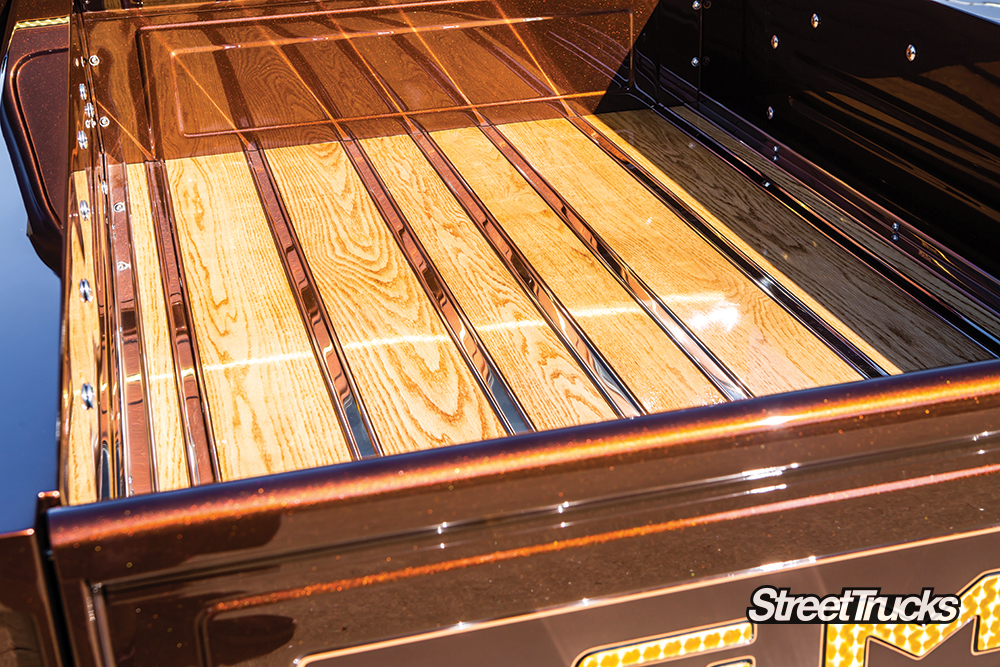
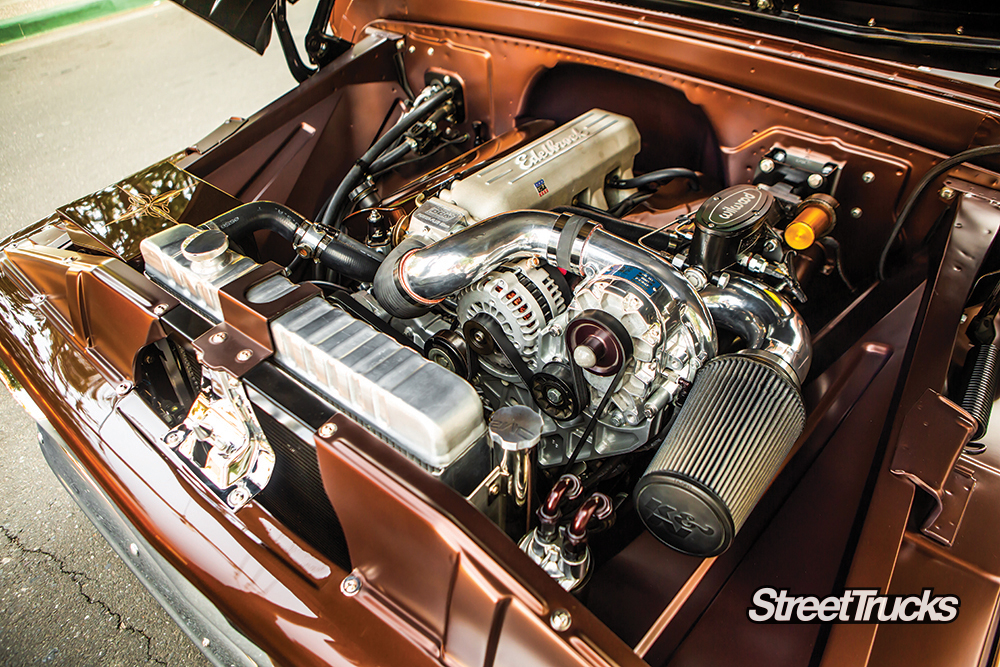 Since the truck just celebrated its 56th birthday, James decided to spend some extra money and spring for a complete custom chassis from Scott’s Hotrods while they were still in Oxnard, California. Not wanting to mess with an air suspension system and all the components that go along with that type of setup, James felt compelled to go ahead and run Aldan America coilovers for performance reasons. The coilovers, along with the custom A-arms, spindles and rear 4-link, now allow the GMC to ride more smoothly than ever before while making it more agile and nimble. To bring the truck to a quick halt, upgraded Wildwood rotors and calipers were added to each corner, which just happen to look slick behind the 18-inch 10-spoke American Racing Rodder wheels.
Since the truck just celebrated its 56th birthday, James decided to spend some extra money and spring for a complete custom chassis from Scott’s Hotrods while they were still in Oxnard, California. Not wanting to mess with an air suspension system and all the components that go along with that type of setup, James felt compelled to go ahead and run Aldan America coilovers for performance reasons. The coilovers, along with the custom A-arms, spindles and rear 4-link, now allow the GMC to ride more smoothly than ever before while making it more agile and nimble. To bring the truck to a quick halt, upgraded Wildwood rotors and calipers were added to each corner, which just happen to look slick behind the 18-inch 10-spoke American Racing Rodder wheels.
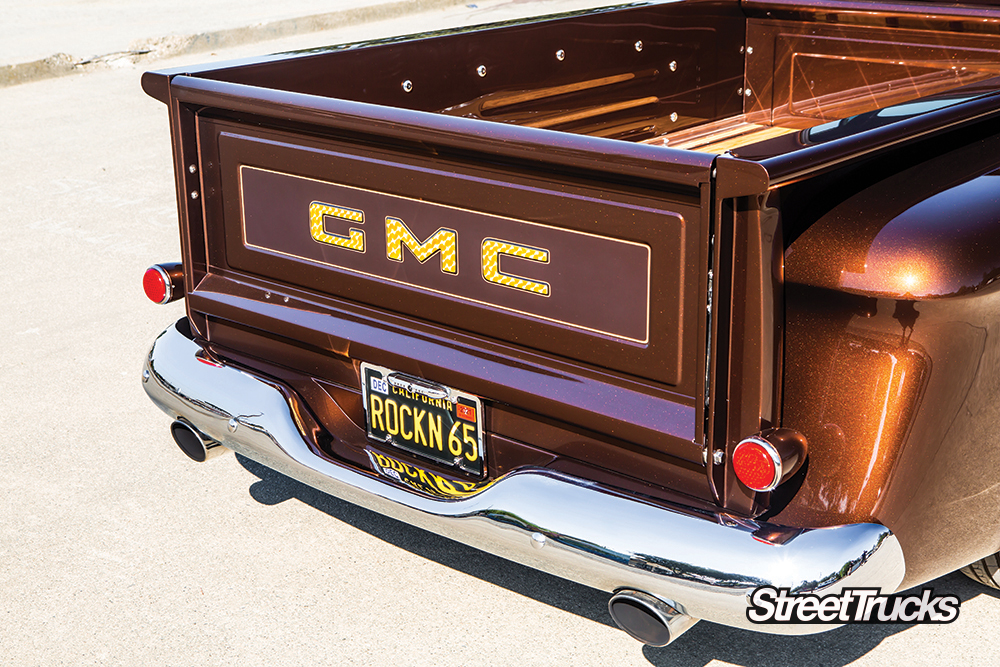 To get the wheels spinning and put the suspension into motion, James treated the GMC to a 2009 630-hp blown LS1 engine built by Rex Hutchison Racing in Sacramento. Yeah, it was a bit of a splurge, but nothing was too good for dad’s old pickup. While in the shop, the LS was topped off with a ton of top-shelf products like a Vortech V-2 SC1 supercharger, K&N intake system, Edelbrock manifold and Hedman headers that blow through to a custom 3-inch exhaust system. All these upgrades and then some were added to the GMC’s ever-growing arsenal list, which dad never would’ve thought to spend money on under the hood. It would’ve all added up to too much, and the truck would’ve been much too fast, but speed and handling are both attributes that James truly loves and appreciates in vehicles.
To get the wheels spinning and put the suspension into motion, James treated the GMC to a 2009 630-hp blown LS1 engine built by Rex Hutchison Racing in Sacramento. Yeah, it was a bit of a splurge, but nothing was too good for dad’s old pickup. While in the shop, the LS was topped off with a ton of top-shelf products like a Vortech V-2 SC1 supercharger, K&N intake system, Edelbrock manifold and Hedman headers that blow through to a custom 3-inch exhaust system. All these upgrades and then some were added to the GMC’s ever-growing arsenal list, which dad never would’ve thought to spend money on under the hood. It would’ve all added up to too much, and the truck would’ve been much too fast, but speed and handling are both attributes that James truly loves and appreciates in vehicles.
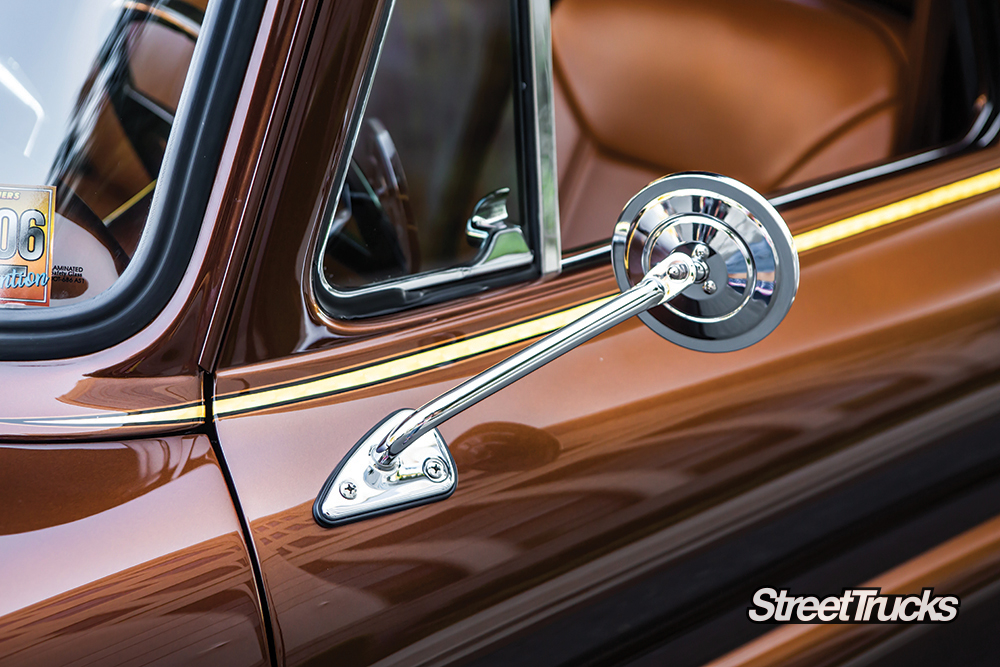
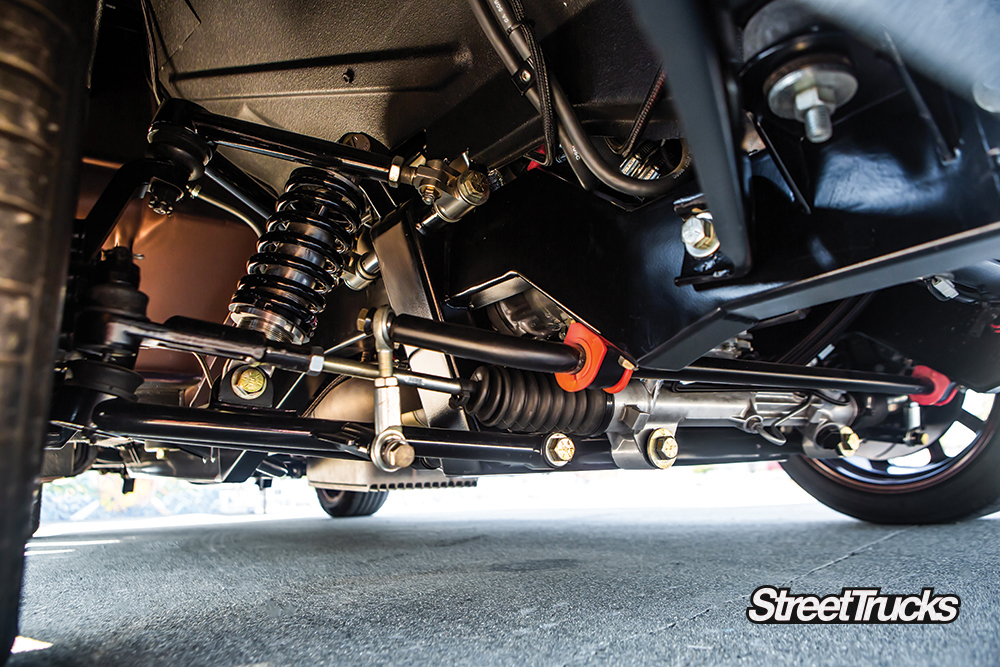 Moving inside the cab, James was dead set on tossing the original seats and going with a much newer bench seat from an ’06 Chevy truck. To properly handle the reupholstery work, Jack’s Upholstery in Woodland, California, was hired for the job. The later-model bench was soon covered in butterscotch vinyl material, new dark brown carpet was laid down, and a bunch of high-quality accessories were then lined up and installed. Classic Instrument gauges, paint matched Lecarra Mark-10 steering wheel and Ididit column, and Vintage Air A/C vents were all imported into the cab, along with a Pioneer receiver for just the right amount of modern convenience.
Moving inside the cab, James was dead set on tossing the original seats and going with a much newer bench seat from an ’06 Chevy truck. To properly handle the reupholstery work, Jack’s Upholstery in Woodland, California, was hired for the job. The later-model bench was soon covered in butterscotch vinyl material, new dark brown carpet was laid down, and a bunch of high-quality accessories were then lined up and installed. Classic Instrument gauges, paint matched Lecarra Mark-10 steering wheel and Ididit column, and Vintage Air A/C vents were all imported into the cab, along with a Pioneer receiver for just the right amount of modern convenience.
Would this be the truck that James’ father would’ve built? Not at all—but the reaction to what has become of his old humble pickup would be so interesting to witness. In all honesty, who wouldn’t be impressed by the outcome of this GMC?
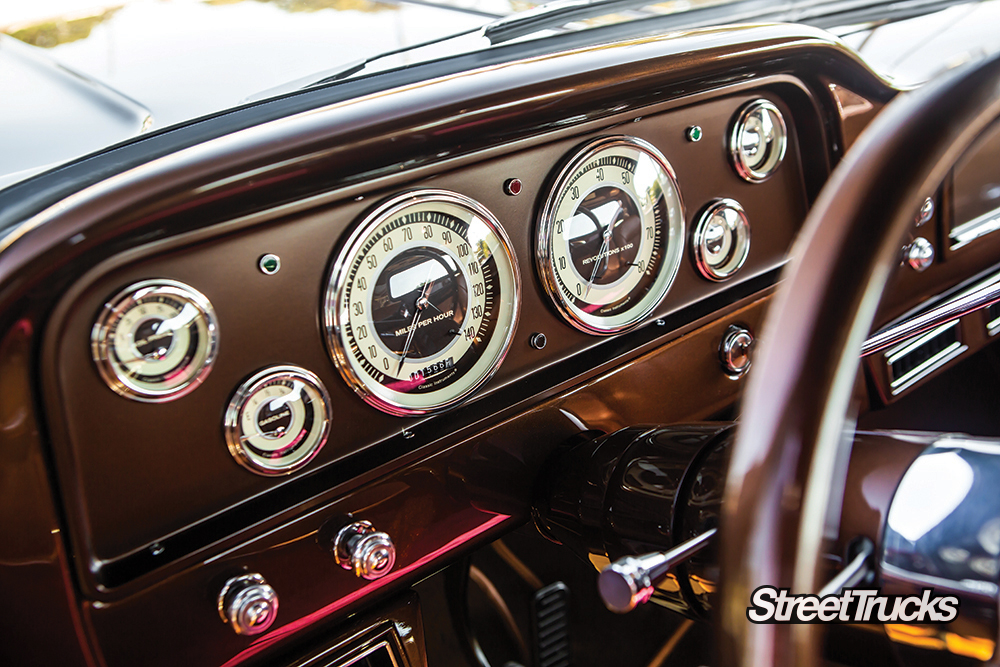
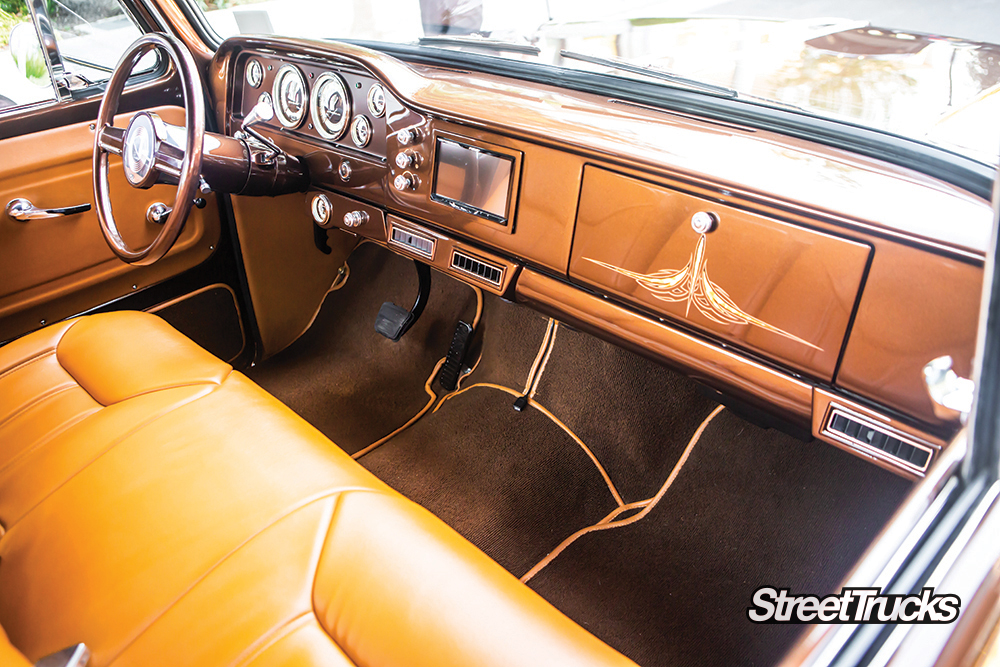 Would this be the truck that James’ father would’ve built? Not at all—but the reaction to what has become of his old humble pickup would be so interesting to witness. In all honesty, who wouldn’t be impressed by the outcome of this GMC? It has become a crowd favorite and a regular trophy-snatcher at every show James takes it to.
Would this be the truck that James’ father would’ve built? Not at all—but the reaction to what has become of his old humble pickup would be so interesting to witness. In all honesty, who wouldn’t be impressed by the outcome of this GMC? It has become a crowd favorite and a regular trophy-snatcher at every show James takes it to.
“I’m sure I’d hear a, ‘What did you do to my truck?’,” says James about what his dad might say about the ’65’s outcome. “But I do think he’d get a big kick out of it.”
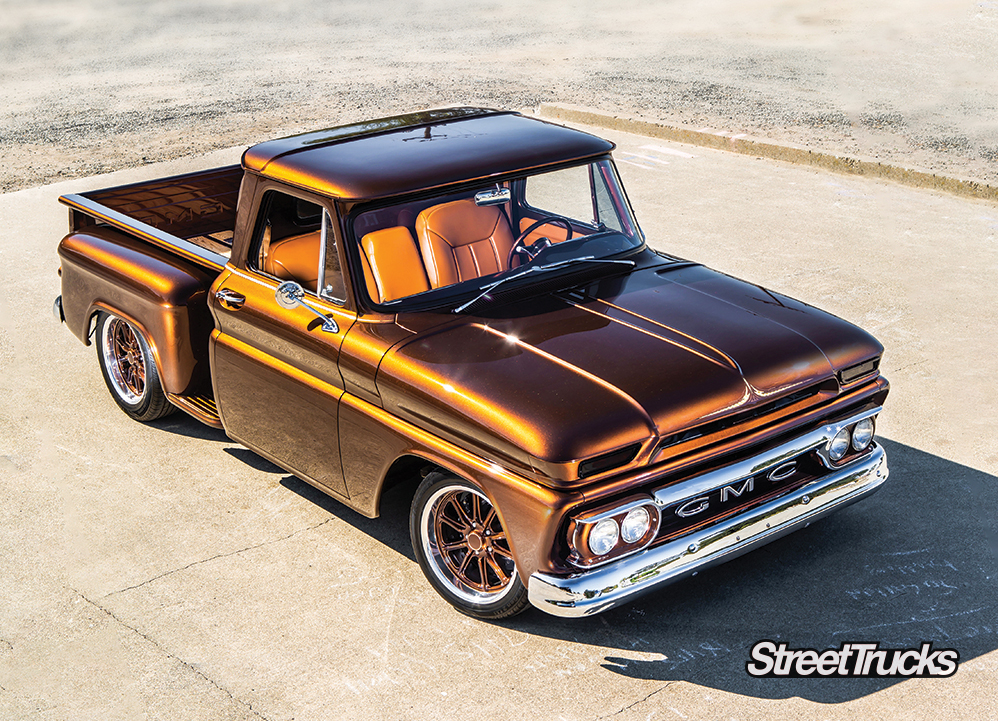 TRUCK SPECS
TRUCK SPECSJames Connerley and Judi Ferreira
Carmichael, CA
1965 GMC C10
How do the users feel about the truck and its restoration journey?
The story of restoring a 1965 C10 Pickup brings to light a mix of admiration and exasperation from its owner. Having acquired the truck brand new in 1965, the user expresses a deep bond with the vehicle. The truck is described as being in its original state until the recent start of restoration.
While working on the engine—a 327 V8 H/O—the user was surprised to find a roller cam, an uncommon feature for engines from that era. Despite owning the truck since its inception and knowing it came from the factory this way, the user struggles to find information about this particular feature, highlighting a feeling of curiosity mixed with frustration.
The truck’s notable factory features include:
Each of these features emphasizes the truck’s original charm and advanced specifications for its time.
Unfortunately, the user’s quest for assistance from the community has been met with a mixture of sarcasm and dismissive replies. This negative reception has led to feelings of annoyance and disillusionment. Despite turning 80in January and insisting they’re not looking to impress anyone, the user simply seeks genuine help and information regarding the truck’s unique characteristics.
The narrative reveals a genuine passion for a cherished vehicle combined with the disappointment of unhelpful responses from fellow enthusiasts. The overall sentiment is one of perseverance; despite the challenges, the user continues their restoration journey, driven by a longstanding connection to their classic 1965 C10 Pickup.
What are the opinions and suggestions from other users regarding the truck’s restoration?
Opinions and Suggestions on the Truck’s Restoration
The suggestions range from preserving authenticity, conducting detailed documentation, and verifying mechanical parts to obtaining more historical context through photos and VIN verification. Collectively, these insights provide a solid foundation for a meticulous and well-documented restoration process.
What additional information do forum members request to help verify the truck’s authenticity?
Forum members request a variety of specific information to verify the authenticity of a truck. This includes:
By collecting this comprehensive information, forum members can piece together a clearer picture of the truck’s authenticity and ensure that the claims about its originality are well-supported.
How do users on the message board verify the authenticity of rare or unusual features in their vehicles?
When it comes to ensuring the authenticity of rare or unusual features in your vehicle, online message boards can be invaluable. Here’s a step-by-step guide that users generally follow:
By following these steps, users can effectively verify the authenticity of any rare or unusual features in their vehicles, leveraging the collective knowledge and expertise available on message boards and beyond.
What are some common issues or misunderstandings when restoring a classic truck?
Restoring a classic truck can be a rewarding project, but it comes with its fair share of challenges and potential misconceptions. Let’s explore some common issues and misunderstandings that enthusiasts might encounter during the restoration process.
One frequent issue is the misidentification of original parts. Many classic trucks went through multiple owners and various modifications. As a result, identifying which parts are factory-original can be tricky. For instance, emblems and engine options might differ between model years. It’s crucial to research thoroughly and source reliable documentation.
Another common pitfall is confusion over the exact model year of the truck. Manufacturers often made small but significant changes mid-year, leading to differences that are easy to overlook. For instance, a truck ordered late in a production year might have parts from the following year. Keeping track of these mid-year updates is essential to ensure authenticity.
Finding authentic parts for a classic truck can be daunting. Many components might be rare and hard to come by, especially if they were specific to a particular model year. Collaborating with reputable third-party suppliers and joining restoration communities can help in locating these rare parts.
Restorers often face a dilemma between maintaining authenticity and incorporating modern upgrades. While purists might strive to keep everything original, others might opt for modern conveniences such as updated brakes or suspension. Balancing these preferences requires careful planning and a clear vision of the desired outcome.
Meticulous documentation is vital for a successful restoration. Original factory records, maintenance logs, and vehicle history reports can provide indispensable information. This documentation not only aids in accurate restoration but also adds value to the vehicle once the project is complete.
Restoring a classic truck involves navigating various challenges and potential misunderstandings. By thoroughly researching, sourcing reliable parts, and keeping detailed records, enthusiasts can ensure their restoration projects are both authentic and satisfying.
Why might there be confusion about parts or features that seem ahead of their time for this model year?
When evaluating classic trucks, it’s not uncommon to encounter discrepancies in parts or features. Here’s why confusion about model years and their corresponding components can arise:
Often, manufacturers introduce updates or improvements partway through a production year. This means you could find features typically attributed to the following model year in a vehicle considered part of the current production run.
Owners frequently modify classic trucks for personalization or restoration purposes:
Occasionally, production phases overlap, causing mixed features:
Historical records or registries may not always perfectly align with the physical reality due to:
Combining elements from different production years or incorporating updates is a common practice. To accurately identify a vehicle’s originality, thorough research and expert consultation are essential. This avoids misconceptions about seemingly anachronistic parts or features of classic trucks.
What is the significance of keeping the truck in its original condition?
When it comes to classic trucks, maintaining authenticity is crucial. Keeping a truck in its original condition offers several key benefits:
Classic trucks that remain in their original state are time capsules, preserving the era in which they were manufactured. This authenticity provides valuable insights into the technology, design, and culture of the time.
Original classic trucks often fetch higher prices in the market. Collectors and enthusiasts prize vehicles that retain their factory features, as these are seen as more authentic and historically significant.
As modifications and restorations become more common, unaltered trucks become rarer. Owning an original vehicle can set you apart in the classic truck community, making your truck a unique specimen.
Preserving a truck in its factory condition allows for an authentic driving experience. You get to feel what it was like to drive the vehicle in its initial release year, providing a nostalgic journey through automotive history.
A truck that hasn’t been altered is easier to document and verify. Original parts, factory finishes, and unmodified mechanics can significantly enhance the truck’s provenance, making it a more credible piece of history.
By focusing on these aspects, you preserve not just the truck, but a piece of automotive history, ensuring it remains valuable and appreciated for generations to come.
What is the history behind the 1965 1/2 C10 Pickup’s special order?
The 1965 1/2 C10 Pickup is a unique gem in automotive history, often coveted by enthusiasts for its blend of power and design. Special ordering a vehicle like this in 1965 provided an opportunity to customize key features and specifications, making it a truly personalized machine.
Specifically, this C10 Pickup was ordered with several noteworthy options that were not standard at the time:
One intriguing discovery during the restoration of this 1965 1/2 C10 Pickup was the presence of a roller cam in the 327 V8 High Output engine. This type of camshaft, known for reducing friction and improving efficiency, was not commonly associated with engines of this vintage. The truck’s long-term owner confirmed its originality, which adds an element of rarity and interest to the vehicle’s history.
The owner’s direct involvement in the vehicle from the initial purchase, through decades of ownership, to the current restoration, highlights a deep connection to this particular C10 Pickup. Such special orders not only reflected the buyers’ needs and preferences at the time but also resulted in a more cherished and valuable classic vehicle today.
By exploring these elements, we can appreciate the unique history and enduring appeal of the 1965 1/2 C10 Pickup. Its blend of custom features, unexpected engineering choices, and the owner’s personal journey all contribute to its storied past and distinguished status among vintage trucks.
What transmission, steering, and differential options were available on this truck?
When considering the available options for transmission, steering, and differential on this truck, there is a variety you can expect:
These features made the truck versatile, catering to both everyday drivers and those seeking enhanced performance.
Does the 1965 1/2 C10 Pickup have a factory-installed roller cam?
The 1965 1/2 C10 Pickup, often a point of curiosity among classic truck enthusiasts, is known for its intriguing blend of features. One of the questions frequently asked is whether it came with a factory-installed roller cam.
In 1965, vehicles predominantly featured flat tappet camshafts, which were the standard of the era. It’s important to note that roller cams were not commonly factory-installed in pickups of this period. Hence, a factory-installed roller cam in a 1965 1/2 C10 Pickup would be highly unusual.
However, some owners who built or customized their vehicles could have upgraded to roller cams. An example can be seen in an individual’s account where they mentioned ordering a 327 V8 engine in their 1965 1/2 C10, and referring to the camshaft as a “Roller Cam.” This strongly suggests it was a possible aftermarket modification rather than a factory default.
Original build sheets, which could provide definitive answers, often suffer deterioration over time. Many enthusiasts face challenges in preserving these documents, and without a complete build sheet, verifying such specific components can be difficult.
In summary, while the 1965 1/2 C10 Pickup did not come with a factory-installed roller cam, certain unique cases involving upgrades or modifications might exist. Enthusiasts interested in the specifics would benefit from verifying through original documentation or consulting with experts who specialize in vintage automotive restorations.
Did the 327 V8 engine come standard in a 1965 C10 Pickup?
The short answer is no, the 327 V8 engine did not come standard in a 1965 C10 pickup.
In 1965, the standard engines available for the C10 were typically smaller, such as the straight-six engines. The 327 V8 was introduced as an option for this model line in 1966, a year after the 1965 models were released.
Moreover, the emblems typically found on a 1965 C10 are mounted on the outer hood cowl panels. This distinctive feature can help you identify the production year of the vehicle if you’re unsure.
In summary, if you’re seeing a 327 V8 engine in a C10, it’s either an aftermarket modification or a 1966 model. Whether you’re restoring a truck or simply appraising it, it’s crucial to understand these nuances.
How do forum members suggest verifying the presence of a roller cam in the truck?
Forum members recommend a practical approach to determine if your truck has a roller cam:
Collecting and sharing detailed images is a straightforward way to get reliable feedback from an online community.
Was a 327 engine available in the C10 before 1966?
Absolutely, let’s dive into the specifics to thoroughly answer the question “Was a 327 engine available in the C10 before 1966?”
The 327 engine wasn’t officially available in the Chevrolet C10 until the 1966 model year. Prior models, including those in 1965, did not offer the 327 as an option straight from the factory.
However, there are some nuances to consider. Trucks ordered late in 1965 sometimes came equipped with features and specifications that would officially only roll out in the 1966 models. This phenomenon is often referred to as “half-year” models. So, if a truck from late 1965 appears to have a 327 engine, it might be one of these “65 1/2” models, which were essentially early versions of the 1966 line.
By understanding these points, it becomes clear that while the 327 engine was not standard in the C10 before 1966, some exceptions do exist due to the unique ordering and production timeframe at the end of 1965.
Are the emblems on the truck consistent with the model year?
To determine if the emblems on the truck match the model year, let’s break down the key aspects:
Given these points, if the truck has emblems placed on the outer hood cowl panels and does not feature a 327engine, it likely aligns with the 1965 model year. On the other hand, if the emblems are positioned differently and the truck houses a 327 engine, it’s more consistent with a 1966 model year.
Ensure to cross-reference these details with verified historical records or consult a classic truck enthusiast community for additional confirmation.
Did Chevrolet trucks from 1965 come with roller cams?
I purchased my 1965 C10 Pickup brand new and I’m currently working on restoring it to its former glory. When I removed the engine—a 327 V8 high-output variant—for an overhaul, I found a surprising component: a roller cam. This discovery was quite unexpected, as I wasn’t aware that engines from this era typically included roller cams.
Factory Specifications:Chevrolet’s standard 1965 truck engines generally didn’t come equipped with roller cams. Most engines from that period utilized flat-tappet cams due to manufacturing norms and cost considerations.
While standard 1965 Chevrolet trucks typically did not come with roller cams, unique scenarios like special orders or early aftermarket modifications could account for their presence. If authenticity is key to your restoration, consult historical vehicle documentation or a classic truck expert for more precise information.
What information can be found on the truck’s VIN tag?
A Vehicle Identification Number (VIN) tag provides a treasure trove of essential details about your truck. When you examine the VIN tag, you can uncover the following key pieces of information:
By decoding the VIN tag, you gain a comprehensive understanding of your truck’s origins, specifications, and unique characteristics. Whether you are verifying the authenticity of a vehicle or simply want to learn more about your truck, the VIN tag serves as a crucial point of reference.
What is the significance of a vacuum gauge in the truck?
A vacuum gauge in a truck serves several valuable purposes:
In summary, a vacuum gauge is an essential addition for anyone serious about maintaining, tuning, or improving their truck’s engine performance and efficiency.
What are some notable features that came with the 1965 1/2 C10 Pickup?
James topped off The LS1 engine with a Vortech V-2 SC1 super-charger, K&N intake system, Edelbrock manifold, and Hedman headers. To seal the deal on the hours that were invested in getting the bodywork and mods just right, Jeff mixed up a custom PPG Envriobase Sunset Bronze color to coat the surface of the GMC. The hue is classy, classic, and oftentimes gets mistaken for ‘root beer,’ but whatever you’d like to call it, the paintwork looks downright fabulous. To capitalize on the freshly shot paint, Dillon Proctor was brought in to add a healthy amount of pinstripe work and gold leafing to the hood, tailgate, as well as some spots inside the cab and a few select suspension components. The coilovers, along with the custom A-arms, spindles, and rear 4-link, now allow the GMC to ride more smoothly than ever before while making it more agile and nimble.
While the modifications bring a fresh lease of life to the GMC, it’s worth noting the heritage it builds upon. Originally, this classic truck boasted impressive features for its time. The 1965 1/2 C10 Pickup came equipped with a Powerglide Transmission, Power Steering, and a 12 Bolt Posi Differential, making it a robust vehicle right from the factory. When the engine—a 327 V8 H/O—was pulled for an overhaul, it revealed a surprising find: a Roller Cam. This was quite unexpected for an engine of this vintage, underscoring the advanced engineering that went into this truck from the start.
By blending modern enhancements with the classic, original features, James has managed to create a vehicle that not only performs exceptionally well but also pays homage to its storied past. The intricate balance of maintaining its historic charm while integrating cutting-edge modifications makes this GMC a standout on the road.
Share Link